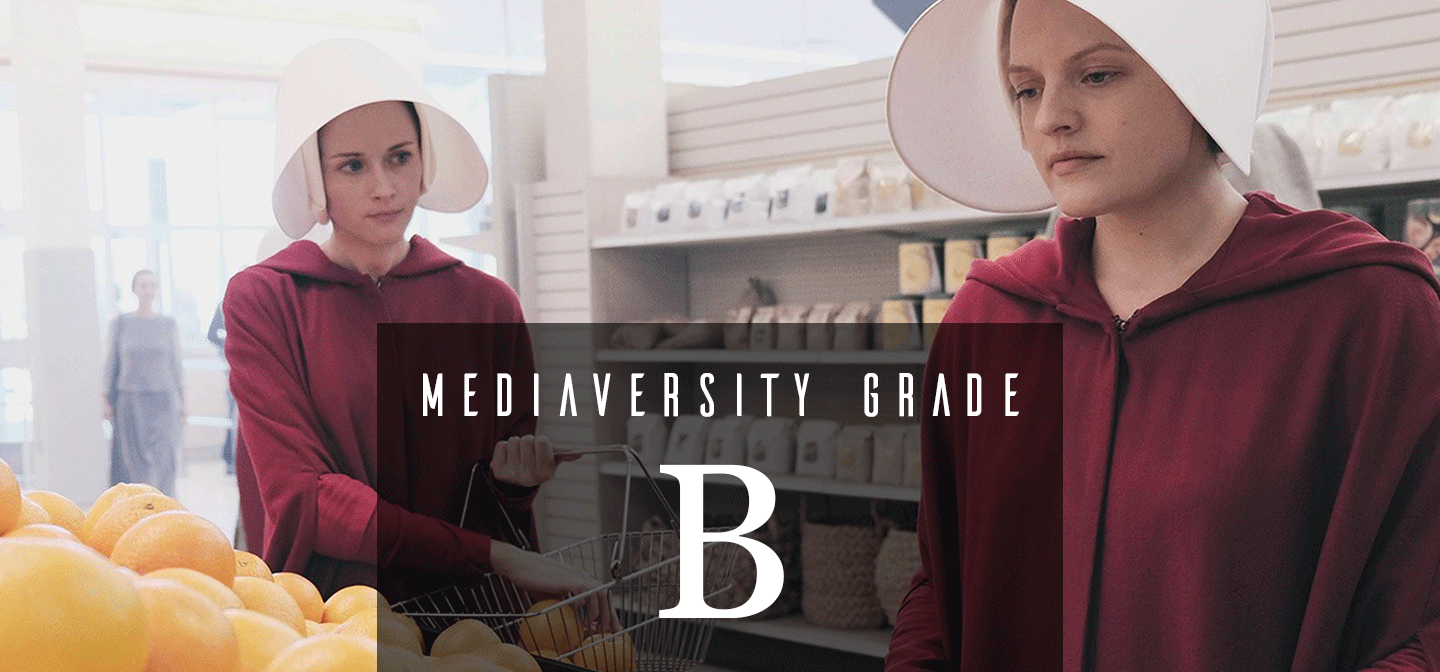The Handmaid's Tale - Season 1
“The Handmaid’s Tale does not grasp the language of racial inclusion.”
Title: The Handmaid’s Tale
Episodes Reviewed: Season 1
Creator: Bruce Miller 👨🏼🇺🇸
Writers: Original story by Margaret Atwood 👩🏼🇨🇦 and TV scripts by Bruce Miller 👨🏼🇺🇸 (10 eps), Dorothy Fortenberry 👩🏼🇺🇸 (1 ep), Leila Gerstein 👩🏼🇺🇸 (1 ep), Lynn Renee Maxcy 👩🏼🇺🇸 (1 ep), and others (3 women, 1 man, no POC)
Reviewed by Tinker 👩🏻🇺🇸
Technical: 5/5
Hulu’s big-budget response to Netflix is Margaret Atwood’s book, movie, and now streaming series, The Handmaid’s Tale. Its latest incarnation has gained critical acclaim from both Rotten Tomatoes (100%) and Metacritic (92%), praised for its cinematography, acting, and handling of incredibly tense and sensitive scenes. The Handmaid’s Tale asserts itself as a believable dystopia where women are categorized, traded, and raped by government officials/powerful leaders.
Though there have been claims of slow pacing, the gradated conflict is necessary. In The Handmaid’s Tale, mere words could lead to cruel punishment or immediate death; brash or haphazard actions would feel misplaced in a show that centers itself around trauma and the time it takes to process it. The main character, Offred (played by Elizabeth Moss), leads a dull but terrifying life as a handmaid, and the pacing echoes that ominous monotony.
The series has now veered from the source material and is confirmed for a second season. Thankfully, rather than continuing the book's dystopian point of view, Miller’s rendition seems to be heading towards a more triumphant direction.
Gender: 5/5
Does it pass the Bechdel Test? YES
The female characters, both protagonists and antagonists (and those in-between), are all expertly written with each character containing their own complexities. Offred is determined and brave, but deeply haunted and constantly second-guessing her decisions. Moira (played by Samira Wiley), her friend from before the takeover, is more rebellious and they support each other during the traumatic events of the story.
While it is undoubtedly the men who orchestrate the hardships of all the women, even the female antagonists wield a considerable amount of power. Often dressed in the blues of the Virgin Mary or the dull browns of the desexualized Marthas, (as opposed to the vivid red of the handmaids, an allusion to Mary Magdalene), their complexity, motives, and relationships with the protagonists provide some of the most layered moments of the show. Despite the regime’s insistence on categorizing these women based on their fertility, all the women—even the antagonists—reject these constraints and sexist labels, as evidenced by their conversations that range from strategies to escape and fond memories of the past, to their children, to support or condemnation for Gilead, the oppressive regime.
Overall, The Handmaid’s Tale depicts a world where women have no overt voice but who find defiance in their own, personal ways.
Race: 2.5/5
When adapting the classic book into a TV series, showrunner Bruce Miller stated, “In a book, it’s easy to say they’ve sent off all the people of color—but on a TV show, seeing it all the time—it’s harder. Honestly, what’s the difference between making a TV show about racists and making a racist TV show?” Thus, he decided to keep racial minorities in the narrative (whereas the book simply explains that all POC are killed). While this decision is laudable, it is unfortunate that Miller stops prematurely. He takes a colorblind approach in having the fundamentalist cult of Gilead be unforgiving of LGBTQ existence, divorce, and female empowerment, yet completely innocent of racism. Max S. Gordon pens an interesting essay that expands on how this dystopia is in fact a white woman’s imagined nightmare—one that black individuals, particularly slaves, had actually lived through and continue to suffer the effects to this day.
Specifically, racial diversity in the show seems to only include two black characters and a sprinkling of background extras of ambiguous ethnicity one would have to squint at to locate. More importantly, all their identities revolve around their relationship to Offred (the white lead). The only POC perspective in the show is an episode following Offred’s husband, Luke, and his escape of Gilead. Yet, nowhere is race mentioned throughout his narrative of escaping a militarized regime on the hunt to kill him and all those who resist their power. Hopefully, a more critical eye will be applied for future seasons; but for now, the diversity in The Handmaid's Tale looks more like a posed college brochure than true incorporations of POC narratives.
LGBTQ: 3/5
Both Moira and Ofglen (Alexis Bledel) are lesbians suffering under Gilead, forced to suppress their sexuality lest they be called “gender traitors” and consequently punished. While Moira’s sexuality isn’t made solely to advance the plot, this unfortunately cannot be said of Ofglen. I assume that Ofglen’s character arc serves to demonstrate what happens to LGBTQ individuals in this society; however, I can’t help but feel that the events within her story also mirror the “Dead Lesbian Syndrome” trope. For the sake of spoilers, I won’t mention more—and there is still hope to address some of the damage done—but for now, the LGBTQ representation remains fairly single-faceted.
Mediaversity Grade: B 3.88/5
The Handmaid’s Tale lives up to the esteemed book, remaining dark, exciting, frightening, and relevant past its 1985 origin. The women are round characters who are far from helpless despite Gilead’s desire for them to be so. LGBTQ characters are present, suffering more than the straight leads, and while the show does not grasp the importance of race, there is still hope for future seasons to mitigate some of its elementary, if well-intended mistakes.

